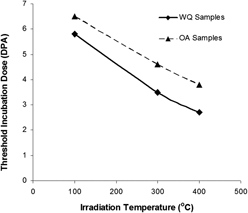Crossref Citations
This article has been cited by the following publications. This list is generated based on data provided by
Crossref.
Yan, Chunguang
Wang, Rongshan
Dai, Xianyuan
Wang, Yanli
Wang, Xitao
Bai, Guanghai
and
Zhang, Yanwei
2016.
Investigation of hardening behavior in Xe ion-irradiated Zr–1Nb.
Journal of Nuclear Materials,
Vol. 473,
Issue. ,
p.
256.
Dai, Cong
Balogh, Levente
Yao, Zhongwen
and
Daymond, Mark R.
2016.
Atomistic simulations of the formation of <c>-component dislocation loops in α-zirconium.
Journal of Nuclear Materials,
Vol. 478,
Issue. ,
p.
125.
Liang, Jianlie
Yu, Hongbing
Barry, Aaron
Corcoran, Emily C.
Balogh, Levente
and
Daymond, Mark R.
2017.
Re-investigation of phase transformations in the Zr-Excel alloy.
Journal of Alloys and Compounds,
Vol. 716,
Issue. ,
p.
7.
Patra, Anirban
Tomé, Carlos N.
and
Golubov, Stanislav I.
2017.
Crystal plasticity modeling of irradiation growth in Zircaloy-2.
Philosophical Magazine,
Vol. 97,
Issue. 23,
p.
2018.
Doriot, S.
Onimus, F.
Gilbon, D.
Mardon, J.-P.
and
Bourlier, F.
2017.
Transmission electron microscopy study of second phase particles irradiated by 2 MeV protons at 350 °C in Zr alloys.
Journal of Nuclear Materials,
Vol. 494,
Issue. ,
p.
398.
Yu, Hongbing
Yao, Zhongwen
Idrees, Yasir
Zhang, He K.
Kirk, Mark A.
and
Daymond, Mark R.
2017.
Accumulation of dislocation loops in the α phase of Zr Excel alloy under heavy ion irradiation.
Journal of Nuclear Materials,
Vol. 491,
Issue. ,
p.
232.
JOUANNY, E.
DORIOT, S.
MALAPLATE, J.
DEHMAS, M.
ALLAIS, L.
THUAUT, M. LE
and
MILLOT, T.
2017.
Evolution of defects in titanium grade 2 under Ti2+ ion irradiation.
Journal of Microscopy,
Vol. 265,
Issue. 3,
p.
275.
Yu, Hongbing
Liang, Jianlie
Yao, Zhongwen
Kirk, Mark A.
and
Daymond, Mark R.
2017.
Effect of heavy ion irradiation on thermodynamically equilibrium Zr-Excel alloy.
Journal of Nuclear Materials,
Vol. 488,
Issue. ,
p.
33.
Doriot, Sylvie
Verhaeghe, Bénédicte
Soniak-Defresne, Annie
Bossis, Philippe
Gilbon, Didier
Chabretou, Valérie
Mardon, Jean-Paul
Ton-That, Marc
and
Ambard, Antoine
2018.
Zirconium in the Nuclear Industry: 18th International Symposium.
p.
823.
Topping, Matthew
Harte, Allan
Frankel, Philipp
Race, Christopher
Sundell, Gustav
Thuvander, Mattias
Andrén, Hans-Olof
Jadernas, Daniel
Tejland, Pia
Romero, Javier E.
Darby, Edward C.
Dumbill, Simon
Hallstadius, Lars
and
Preuss, Michael
2018.
Zirconium in the Nuclear Industry: 18th International Symposium.
p.
796.
Wang, Qiang
Balogh, Levente
Dong, Qingshan
Guo, Ning
Yao, Zhongwen
and
Daymond, Mark R.
2019.
Effects of heavy ion irradiation on Zr-2.5Nb pressure tube alloy. II. Orientation dependent dislocation loop propagation and elemental redistribution.
Journal of Applied Physics,
Vol. 125,
Issue. 8,
Singh, Gaurav
Jayaganthan, R.
Arora, Umesh Kumar
Vishnu Narayanan, K. I.
and
Srivastava, Dinesh
2020.
Texture Analysis and Fracture Behavior of Zircaloy-4 Processed Through Swaging.
Metallography, Microstructure, and Analysis,
Vol. 9,
Issue. 2,
p.
273.
Onimus, Fabien
Doriot, Sylvie
and
Béchade, J.-L.
2020.
Comprehensive Nuclear Materials.
p.
1.
Kano, Sho
Yang, Huilong
Murakami, Kenta
and
Abe, Hiroaki
2022.
Modification of the high fluence irradiation facility at the University of Tokyo: Assessment of radiation-induced amorphization of Zr(Cr,Fe)2 Laves phase under 180 keV-He+ irradiation.
Nuclear Instruments and Methods in Physics Research Section B: Beam Interactions with Materials and Atoms,
Vol. 531,
Issue. ,
p.
1.
Cao, Yucheng
Wu, Tianxian
Xia, Liang
Feng, Pengfei
Jiang, Chao
and
Chen, Ding
2022.
The role of primary α grains in the degree of transformation texture obeying the Burgers orientation relationship in Zr alloys.
International Journal of Refractory Metals and Hard Materials,
Vol. 107,
Issue. ,
p.
105908.
Doriot, Sylvie
Verhaeghe, Bénédicte
Toffolon-Masclet, Caroline
Bossis, Philippe
Bourlier, Florent
Ton-That, Marc
and
Ambard, Antoine
2023.
Zirconium in the Nuclear Industry: 20th International Symposium.
p.
568.
Xia, Liang
Cao, Yucheng
Liu, Kai
Chen, Ding
and
Jiang, Chao
2024.
Effect of Fe addition and ion irradiation on surface hardness in zirconium alloys: Experiments and modeling.
Applied Surface Science,
Vol. 669,
Issue. ,
p.
160480.
Koç, Ö.
Thomas, R.
Liang, X.Z.
Hegedüs, Z.
Lienert, U.
Harrison, R.W.
Preuss, M.
Ungár, T.
and
Frankel, P.
2024.
A spatially resolved analysis of dislocation loop and nanohardness evolution in proton irradiated Zircaloys.
Acta Materialia,
Vol. 269,
Issue. ,
p.
119799.
Kong, Xianggang
Wang, Qingqing
Yu, You
Shen, Yanhong
Zhang, Chuanyu
Pan, Rongjian
Kharchenko, Dmitrii O.
Mao, Jianjun
Ning, Zhien
Fang, Zhongqiang
and
Wu, Lu
2024.
Effect of solute Nb and Sn on self-interstitial atom defect in zirconium-based alloys by first-principles calculations.
Journal of Nuclear Materials,
Vol. 588,
Issue. ,
p.
154795.
Wang, Zhen
Yan, Qing-Xue
Fang, Zhong-Qiang
and
Lu, Chen-Yang
2024.
In-situ TEM investigation of zirconium alloy under Kr+ single-beam and Kr+-He+ dual-beam synergetic irradiation.
Nuclear Engineering and Technology,
Vol. 56,
Issue. 8,
p.
3129.
